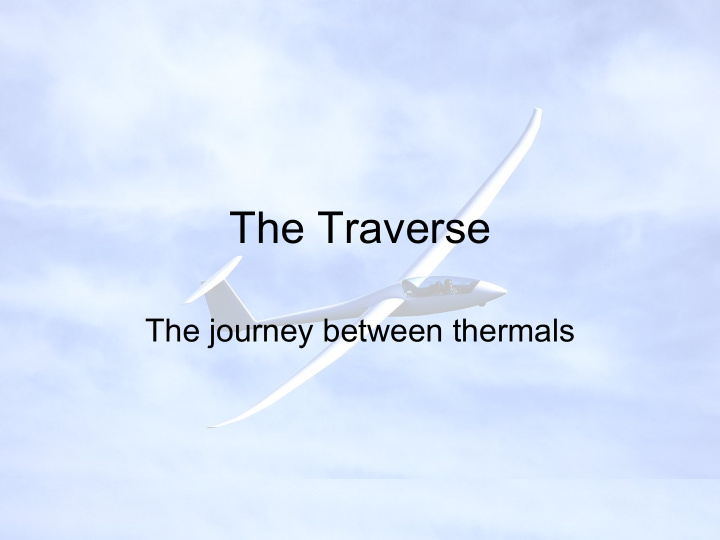



The Traverse The journey between thermals
X country speed is related to: • Cruising speed • Climb rate • Route through the air
What speed to fly • McCready theory • Block speeds or dolphin?
McCready theory • For every thermal strength there is an optimum speed to fly between thermals to give the fastest average speed. • Anticipated climb rate for the next thermal will give a speed to fly towards that thermal
Devised from the gliders performance curve
Discus without water ballast Thermal in Knots 1 2 3 4 5 6 7 8 Cruise speed 62 68 75 78 83 84 86 88 knots Average x 46 70 80 94 102 110 114 121 country speed Kilometers per hour
Ingo’s table of speed to fly Lift Heavy Light High Low High Low 0 60 55 55 50 1 70 65 65 60 2 75 70 70 65 3 80 75 75 70 4 85 80 80 75 5 90 85 85 80 6 95 90 90 85 7 100 95 95 90 8 105 100 100 95
MacCready rules of thumb • Steadily reduce the MacCready setting as you get lower -- fly more slowly and take weaker thermals • MacCready settings are substantially lower than best climbs. • The MacCready value now should be the same as you expect it to be ahead.
• Speed to fly changes with wing loading • Leave weak thermals to go find better lift, as you get higher • Sometimes it pays to trade speed for distance • never set the ring to zero; penalty is to high • Conservative ring settings increase your chance
The speed you fly shows the confidence that you have for the future •
What is my average climb rate? • VAR t average from start of circling to leaving thermal • Half the average climb rate
flying slower Average climb rate 6 knots Cruise speed 6 5 4 3 2 1 0 setting in knots Average x 110 109 108 106 103 93 88 county speed Reduction in 39 34 30 25 18 5 _ search area %
Flying slower
Speed=Range
2 2 2 Range, but slow if you do find lift 5 4 Good speed if you do, 5 3 Good range if you don’t 2 Fast, but no range if you don’t find lift 5
Effective inter thermal flying the pilot should alter direction using visual clues: • clouds • gliders • terrain • or instrument-Netto To minimize height loss
Effective Inter-thermal Flying • Set a working height band for the day • below what height are the thermals weak and difficult to work? • At what height does the thermal strength drop off • These altitudes will change throughout the day!
Operating height band- aggressive and fast Caution height band – conservative, a bit slower Survival height band –just stay in air
Effective Inter-thermal Flying • Identify patterns of lift under clouds • Look for patterns of lift using clouds and haze domes • Look for good thermal sources and streets • Look ahead 50-100km • When high, look at cloud shadow patterns, when low look at cloud patterns.
Effective Inter-thermal Flying • When you feel lift always slow down and turn into it • Anytime you can climb while flying straight on course is advantageous
Deviations Degrees off track Degrees off track On On 10 10 20 20 30 30 40 40 50 50 track track Thermal Thermal 1.0 1.0 1.0 1.0 1.2 1.2 1.5 1.5 1.6 1.6 2.6 2.6 strength strength 2.0 2.0 2.0 2.0 2.2 2.2 2.8 2.8 3.6 3.6 5.8 5.8 3.0 3.0 3.0 3.0 3.4 3.4 4.2 4.2 6.0 6.0 9.6 9.6 4.0 4.0 4.2 4.2 4.8 4.8 5.8 5.8 8.2 8.2 13.6 13.6 5.0 5.0 5.2 5.2 6.0 6.0 7.4 7.4 10.6 10.6 17.4 17.4 6.0 6.0 6.2 6.2 7.0 7.0 8.8 8.8 12.6 12.6 10.6 10.6
Momentum and rhythm • Fly smoothly, minimize control movements • In calm conditions fly peacefully • In rough conditions fly excitedly
Final glides
Final glides • A well flown final glide will increase the average speed considerably • Be aggressive far out and conservative when close and low • If gaining on the glide speed up • If losing, find a climb • high ring setting = high safety margin
Final glides Coffin corner on final glide Where would you thermal or land? Mc3+300’ Mc3 = 80kts dry, 90 kts wet 2000 Critical zone 1500 Decisions: 300’! 1000 Mc0=53 kts 500 Low slow finish 0 10 5 0 Last minute landing
High finish removes coffin corner 3000 •Not “safety finish ”: •50’ is not enough. 500’ min. •Cannot give speed pts for rolling finish 2500 Mc3 • Crucial: don’t press on from critical zone Mc0 •“But I made it back” = “But I got so close” 2000 Glide home 1500 Stop, thermal, look at fields Finish 1000 Ex - Critical zone 500 Pattern, Land 0 10 5 0
Summary • The fastest average speed can be obtained by improving the climb rate rather than any possible variation in speed between thermals. • By selecting only the strongest thermals will the fastest speeds be achieved. • There are no hard and fast rules, everything depends on the circumstances
Recommend
More recommend